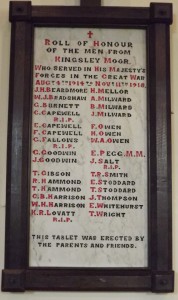 St John’s was for many years and certainly during the war closely associated with St Werburgh’s Church.
St John’s was for many years and certainly during the war closely associated with St Werburgh’s Church.
During the war a scroll was kept recording the names of those men who were serving in the armed forces.
After the war these names were transferred to stone tablets and unveiled at the Church in 1920.
Reports in local newspapers for 1920 show how many communities were active in erecting their own memorials and St John’s was one of the first.
The tablet was unveiled on Sunday 29th February that year and reported in the Weekly Sentinel on 6th March.
The unveiling was so well attended that many could not gain access to the church to witness Brigadier General Sir Hill Child (the local Member of Parliament as well as a professional soldier) unveil the tablet. He later served in the Royal Household in an number of roles to the King and the current Queen. He made a short speech and then removed the Union flag that was draped over the tablet.
The Rector asked the two wardens Mr Capewell and Mr Harrison to take charge of the tablet – Mr Capwell was the father of Colin Capewell named on the tablets and also on Kingsley’s memorials having lost his life in 1918 due to the effects of gas. Mr Capewell – also called Colin was described as being very emotional. Read Colin Capewell’s story HERE
The tablet which is pictured above is made of marble and framed in oak. Adjoining was a wreath of laurel leaves. The cost was funded by the local residents and the congregation at the church and was made locally albeit the report does not name the masons.
Many years later the church was sold off by the church and the whereabouts of the tablet was unknown. Peter Capewell the son of Ernest and nephew to Colin and Frederick Capewell spent some time trying to track it down as it was no longer in the church (now a private residence) He worked for Keate’s Undertakers so was often in Kingsley and the surrounding villages.
One day he was in attendance at a funeral in St Werburgh’s and the tablet was there propped up against a wall. No one knew how it happened to have got to the church but clearly Peter’s actions saved the tablet which is now on display on the wall inside the church alongside one for those who died from the wider parish.
The tablet is in fact a piece of history as it does not just name those who died but it names all the men who served from Kingsley Moor in the war. Few such records exist and we should be grateful to Peter who’s efforts ensured these mens names are not forgotten.
